National Catholic Reporter
May 24, 2010
http://ncronline.org/news/women-religious/global-women-religious-new-catholic-leadership
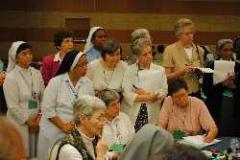 |
| 800 women religious congregation heads gathered in Rome May 7-11. Faces of other conference women religious below. Photo by Tom Fox |
Before the women of the Leadership Conference of Women Religious sat down for business last August in New Orleans, they crammed into buses and spent a half day visiting their local sisters who were attending to the needs of the dislocated and dispossessed of the 2005 hurricane and floods. The women came to offer solidarity, give encouragement, and check out the fruits of the more than $8 million raised through their efforts for a number of local ministry projects.
When women religious leaders from throughout Asia and Oceania gathered last October outside Bangkok, Thailand, to reconnect, share stories and generally lift each other’s spirits, they took time during their meeting to learn more about the two Vatican investigations of their sister religious across the globe, in the United States. The women from Australia and New Zealand had the most information and shared it with the Asians. Once informed, the entire group sent a brief letter off to their U.S. sisters as a sign of support and solidarity..
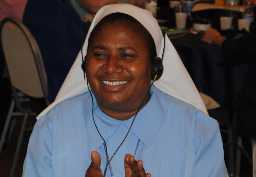 |
Photo by Tom Fox |
Earlier this month, when some 800 international women religious congregation leaders gathered in Rome (see story on Page 1), they talked about ways wealthier congregations could assist poorer ones, many of them located in impoverished Africa, India and Pakistan. Later, women worked together on a declaration outlining their intentions to strengthen the Union of International Women Religious General Superiors, under whose auspices they met, to more quickly share common challenges and local needs.
In one session, Sr. Pat Murray, a Loretto sister from Ireland and executive director of the Solidarity With Southern Sudan project, spoke about how 19 religious congregations, including both men and women, have for the past two years pooled resources to provide assistance in one of the most destitute locations on earth. The group now trains teachers and health care workers. In the process, they hope to set an example showing how people can cross languages, nationalities and cultures to build a peaceful society. In war-torn southern Sudan, the presence of this unique interreligious group offers example and hope.
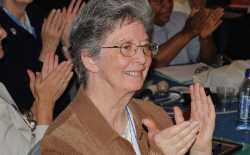 |
Photo by Tom Fox |
On another day, a Congolese African woman religious combined the conference’s themes of mysticism and prophecy as she spoke about the courageous work of African women religious, more than 200 of whom have been slaughtered by local militias. Given a chance to flee in the face of marauding gunmen, the women repeatedly chose to stay with the villagers. Her talk highlighted the raw courage of inspired women religious, adding new spiritual resolve to those who listened.
Later that woman, Sister of Notre Dame de Namur Liliane Sweko explained that her vision of consecrated life has been hugely shaped by the writings of Immaculate Heart of Mary Sr. Sandra Schneiders and Benedictine Sr. Joan Chittister. She said she only regretted that all of Chittister’s works have yet to be translated into French, the common language of many of the women religious of West and Central Africa.
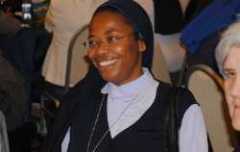 |
Photo by Tom Fox |
However if U.S. women religious have inspired Sweko, she now was inspiring them with her earthy stories of selfless love. And coming from the Philippines, Religious Sister of Cenacle Judette Gallares was equally inspiring in a talk in which she used the example of Lydia, an early Christian convert, as someone who helped transform lives by refusing to live by traditional norms that excluded women’s gifts.
The above are but a few furtive glances behind the curtains of a magnificent and underreported church story. It is a hope-filled story still mostly buried under the now widely reported tale of clergy sex abuse and episcopal cover-up.
The core of this 21st-century church story is the emergence of the global sisterhood of the sisterhood. It is the story of women religious congregations and their leaders coming together in solidarity across national, cultural and linguistic lines in common cause. It is a story of women who are increasingly connected, electronically and spiritually, driven by the call of the Gospels and teachings of the Second Vatican Council. It is the story of women religious who, by choice and necessity, have stopped competing for vocations and mission placement and are instead working together, in traditional habit or local dress, to bring solace to the suffering of the world. It is the story of women, marginalized within their own institution, teaching other women how to overcome prejudice and live beyond it. It is the story of self-generative spirits having decided to set their own Christian courses. It is the story of how education empowers and how scriptural and theological studies have liberated women across the globe. It is the story of nurturers, using intuition and knowledge, to respond to God’s creation, now under mindless attack. It is, actually, an old story set in a new century: women religious responding yet again to the joys and hopes, sorrows and anxieties of the people of God.
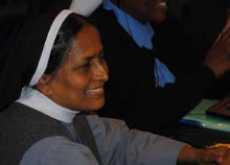 |
Photo by Tom Fox |
This story could not have attained a shape (nor could it be gathered to be told) without the Internet. The world’s most remote missions now have dedicated Web pages. Some of the most isolated religious can stay in contact with their sisters in faraway places through e-mail. Ideas and experiences are readily shared online or in meetings. Plans become forged. More than 600,000 women religious globally are now networked together.
What has emerged, without intention and seemingly by the default of a paralyzed episcopacy, is a parallel leadership structure within the church. These prayerful women have pondered their souls and their congregation’s constitutions and, empowered by each other, are reaching farther than they ever might have imagined.
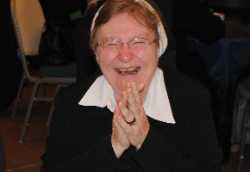 |
Photo by Tom Fox |
They live without illusion. They know they have no official place at the males-only table around which decisions are made. So, instead of feeling weakened, they have learned the art of self-empowerment. Rich in determination, they get on with their work, often unrecognized by those in official leadership, who should be showering the women with accolades.
Instead, of course, the U.S. women face twin Vatican investigations.
The reality of their standing within the church was dramatized at the global women religious meeting this month. While, canonically, leaders of all 800 women religious congregations represented in Rome report to Slovenian Cardinal Franc Rode, prefect of the Congregation for Institutes of Consecrated Life and Societies of Apostolic Life, the prelate sent word he was “unable” to attend the once-in-three-years gathering, taking place some three miles from his office. On the women’s schedule for the last day, a program planned for years, was an audience with Pope Benedict XVI. However, he canceled, having decided to visit Portugal, which included a well-publicized visit to the shrine of Our Lady of Fatima.
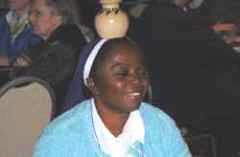 |
Photo by Tom Fox |
What keeps their situation from being downright tragic are the women themselves and their faith-filled understanding of the biblical dynamic of great strength emerging from the powerless.
To pay attention to the ministries of our church’s women religious is to hear an increasingly clear articulation of what it means to be a Christian in the 21st century. These women are claiming their experiences as sacred callings, and in so doing, are encouraging the rest of us to live out our Christian vocations, whatever hardships these might involve.
[This is the editorial from the May 28, 2010, issue of National Catholic Reporter. In the print issue, this editorial is titled: "Strength emerges from the powerless."]
Any original material on these pages is copyright © BishopAccountability.org 2004. Reproduce freely with attribution.